As Hong Kong’s capital markets regain momentum, companies face a reshaped fundraising landscape. With renewed liquidity comes fresh opportunities and new rules of engagement for capital-hungry firms. Sophie Cheng reports
In the past year, the initial public offering (IPO) markets in Hong Kong, the US and mainland China have told a tale of mixed fortunes. Benefiting from policy tailwinds and market conditions, a surge of A-share listed companies seeking a dual listing status in Hong Kong, mainly featuring hard tech and new quality productive forces, has carved out a window of opportunities for Hong Kong’s capital market.
Meanwhile, mainland companies eyeing US listings continue to find niche opportunities amid geopolitical headwinds in specialised sectors, although multidimensional challenges still loom. The persistently sluggish mainland IPO market mirrors a regulatory environment of “tightened oversight, enhanced compliance and performance-driven scrutiny”, underscoring a paradigm shift towards quality and sustainable development for listed companies.
With the implementation of the filing-based system for overseas listings of domestic enterprises, companies must now have a deep grasp of the evolving review processes and underlying regulatory logic for listings in Hong Kong and the US to improve their chances of getting filings approved. The cooling frenzy around the innovative capital vehicles represented by special purpose acquisition companies (SPACs) is also prompting IPO candidates to adopt a more prudent approach.
Hong Kong boom
This year, Hong Kong’s IPO market has staged a long-awaited and remarkable resurgence, with a vibrant scene of numerous issuers vying for prominence. In May, Chinese electric vehicle battery maker CATL made a stellar debut on the Hong Kong bourse as the year’s largest IPO worldwide by size, adding a bold stroke to this capital market revival.
In the first four months this year, 116 listing applications were filed with the Hong Kong Exchanges and Clearing (HKEX), up from 89 listing applications submitted during the same period last year. Among these filings, Ronny Chow, a partner and head of the corporate finance practice group at Deacons in Hong Kong, has noticed a higher proportion of first-time applications (versus refiling after the initial listing application has lapsed), as compared to the same period last year.
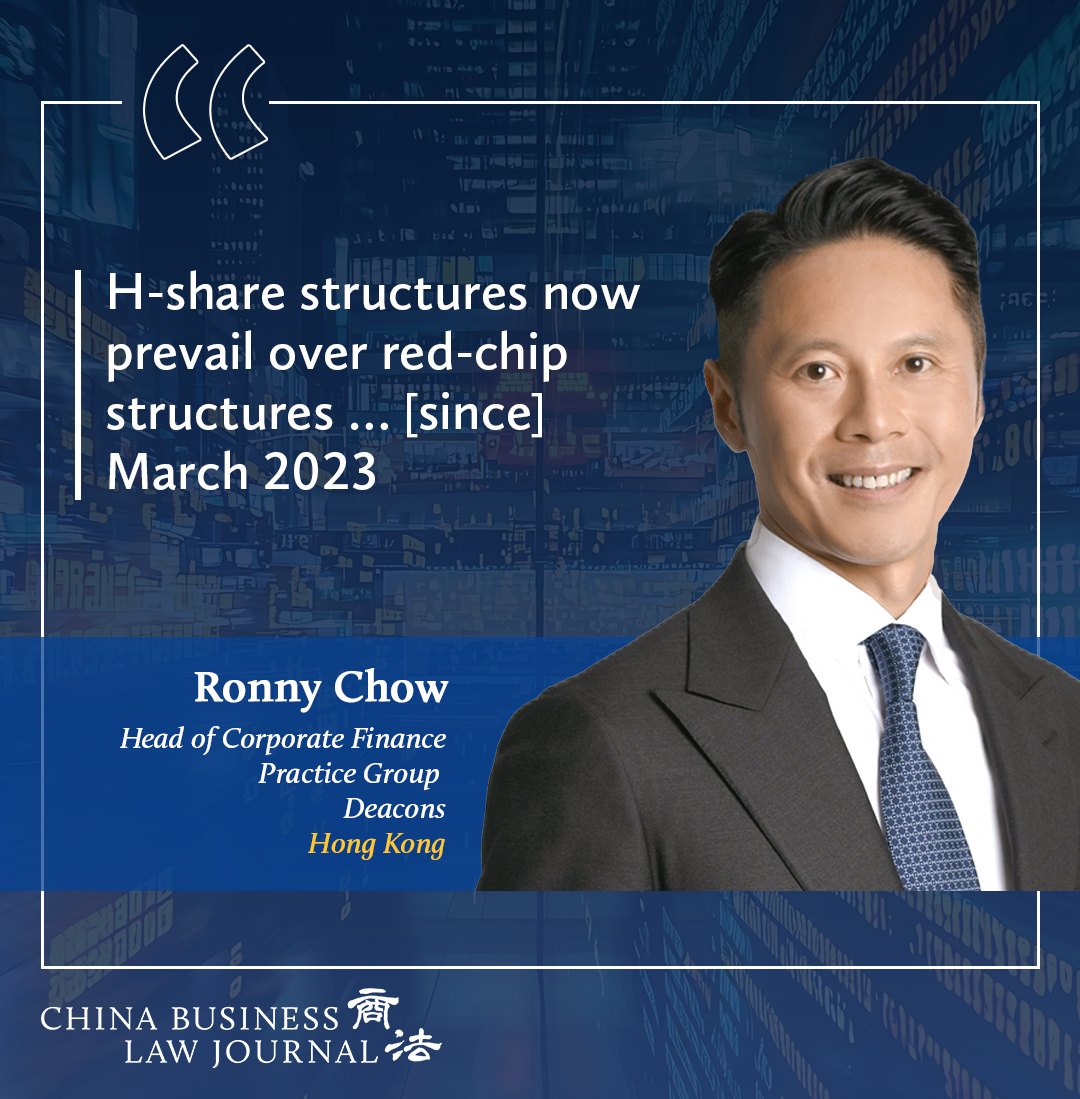

Mainland companies remain the dominant force in the Hong Kong IPO landscape. Nan Li, the managing partner of Tian Yuan Law Firm’s Hong Kong office, highlights a defining feature that sets the current boom apart from all previous ones: China’s top-tier innovators are no longer “crossing the river by feeling the stones laid by the US”.
“Unlike the era of ‘copy from the US’, ‘me too’ or ‘me better’ strategies that defined past generations of followers, this time it is a China-led story where Chinese enterprises are driving global technological advancement and innovation,” says Li.
A trend of A-share companies seeking an A+H dual listing in Hong Kong has also become obvious. As of 30 April this year, there were a total of 25 active A+H listing applications, compared to only three as of 31 December 2024.
“H-share structures now prevail over red-chip structures following the implementation of the new filing regime introduced by the China Securities Regulatory Commission (CSRC) in March 2023, which is applicable to all companies with principal operations in mainland China,” says Chow. “Red-chip structures are mostly confined to companies that had their offshore ownership arrangements in place prior to 2023.”
Yet, Nelson Tang, a partner at Hogan Lovells based in Hong Kong, cautiously attributes this rebound to “mainly a result of certain large-scale IPOs rather than an increase in volume of successful listings, indicating a concentration of capital in fewer, larger deals”.
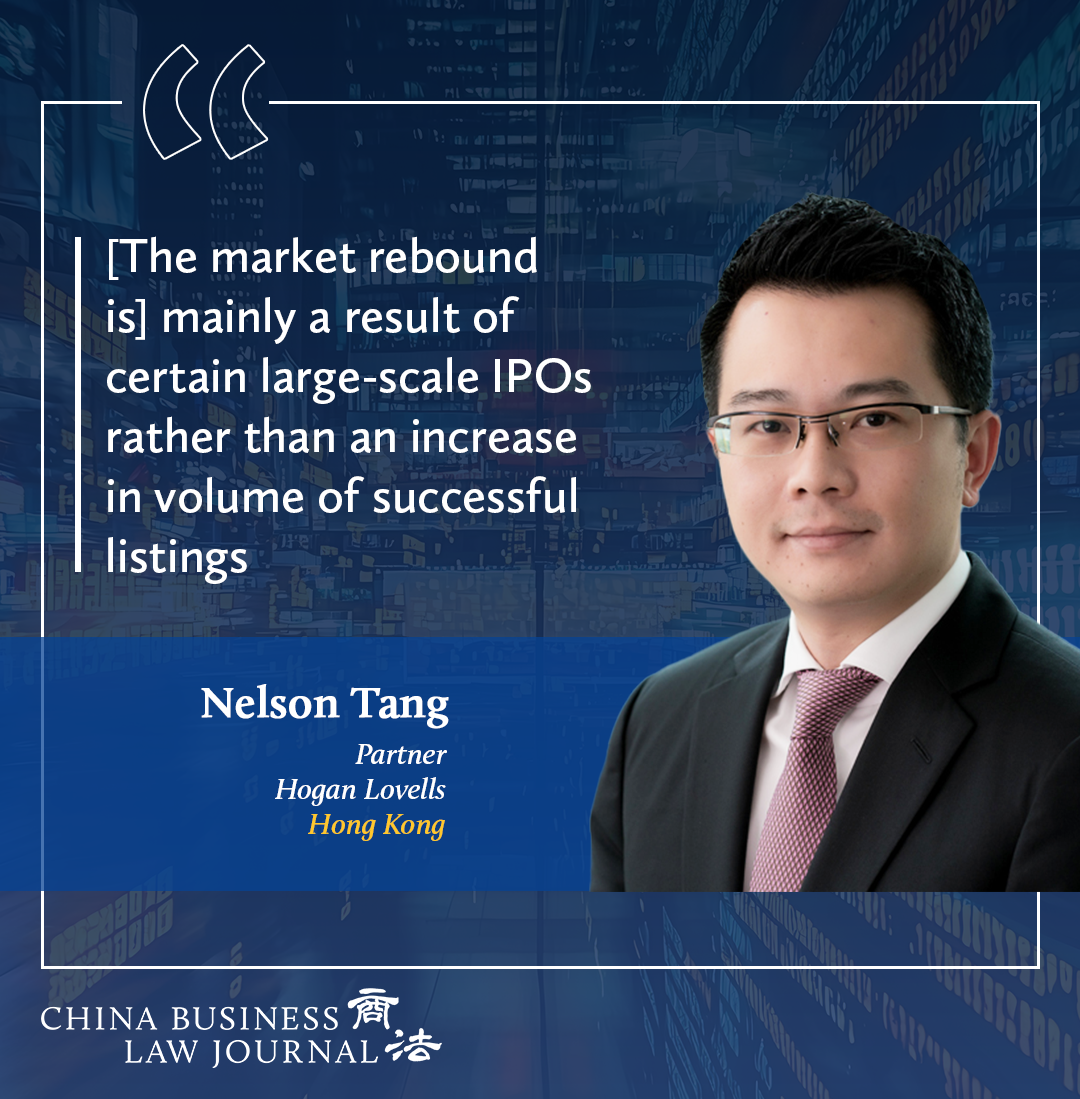

In terms of sector distribution, Tang has seen increasing interest from investors in artificial intelligence, advanced technologies, energy and the consumer industry, while Chow observes that based on the current pipeline, the market focus includes AI, IT solutions, semiconductors, electric vehicles, smart charging, biotech, healthcare and consumer markets adopting “omnichannel+” models.
The resurgence of Hong Kong’s IPO market is underpinned by bold policy incentives from mainland and Hong Kong financial regulators in recent years. In April 2024, the CSRC introduced five measures to strengthen capital market co-operation with Hong Kong, supporting leading mainland enterprises in pursuit of Hong Kong floats.
This was followed by the joint statement on the enhanced timeframe for the new listing application process from the Securities and Futures Commission (SFC) of Hong Kong and the HKEX in October, establishing a “fast-track review channel” for qualified A-share companies valued at more than HKD10 billion (USD1.3 billion).
According to Guo Xiaodan, an equity partner at Zhong Lun Law Firm in Shenzhen, under these supportive policies, the filing cycle for companies meeting the criteria of market capitalisation of more than HKD10 billion with complete compliance records can now be shortened to 65 business days.


Since March 2023, when the HKEX unveiled a listing regime for specialist technology companies which encompasses AI, semiconductors, new energy and other hard tech sectors, Guo has observed a clustering effect among tech enterprises on a significant scale.
“Recent cases demonstrate the HKEX’s strategic pivot from being a ‘rule follower’ to a ‘system innovator’ in vying to become the premier listing destination for global hard tech firms,” she says. “For specialist technology companies planning to go public in Hong Kong, the verifiability of their technological barriers and the sustainability of research and development investments will prove decisive in clearing the listing hurdles.”
This May, the SFC and HKEX jointly launched the Technology Enterprises Channel, designed to streamline the listing process for specialist technology and biotech companies. They also introduced a new confidential filing option for these companies.
Chow explains that the publication of draft listing documents at the time of application may result in premature and prolonged disclosure of information on their operational strategies and proprietary technologies in view of the nature of their businesses and industries.
Dubbed by the market as the “first AI Agent IPO”, Yunji Technology filed a fresh application for a Hong Kong listing in March this year. Li, who helms the legal team that leads the drafting of the prospectus, notes that the filing immediately drew significant attention and inquiries from market practitioners.
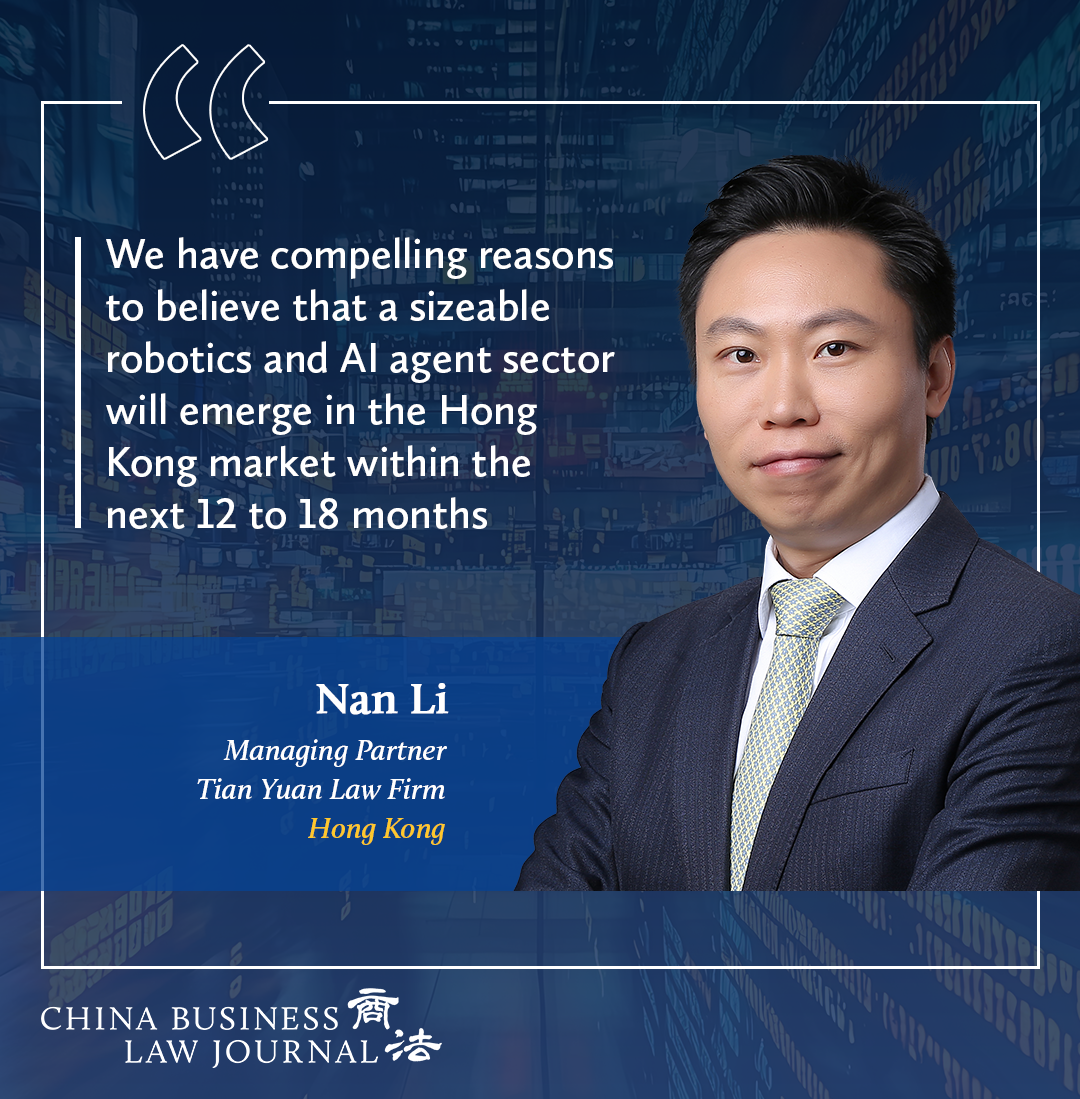

“Based on the projects we are currently handling and our observations of similar cases in the market, we have compelling reasons to believe that a sizeable robotics and AI agent sector will emerge in the Hong Kong market within the next 12 to 18 months,” says Li. “This is expected to exert a strong gravitational pull on both domestic and global capital. IPO candidates should accelerate their pace to seize this once in a five-to-10-year window of opportunity for the Hong Kong IPO boom.”
Xu Ying, a founding partner at Jia Yuan Law Offices’ Hong Kong branch, echoes this sentiment. Last September, Jia Yuan advised Midea Group’s Hong Kong listing, the city’s largest in three years. “It is Midea’s debut that marked the turning point in Hong Kong’s IPO resurgence,” says Xu. His team’s recent mandates, including IPO preparations for consumer giants, such as Foshan Haitian Flavouring & Food, Eastroc Beverage and Bama Tea, reinforce his conviction that industry leaders in consumer and tech sectors are highly favoured by the capital market.
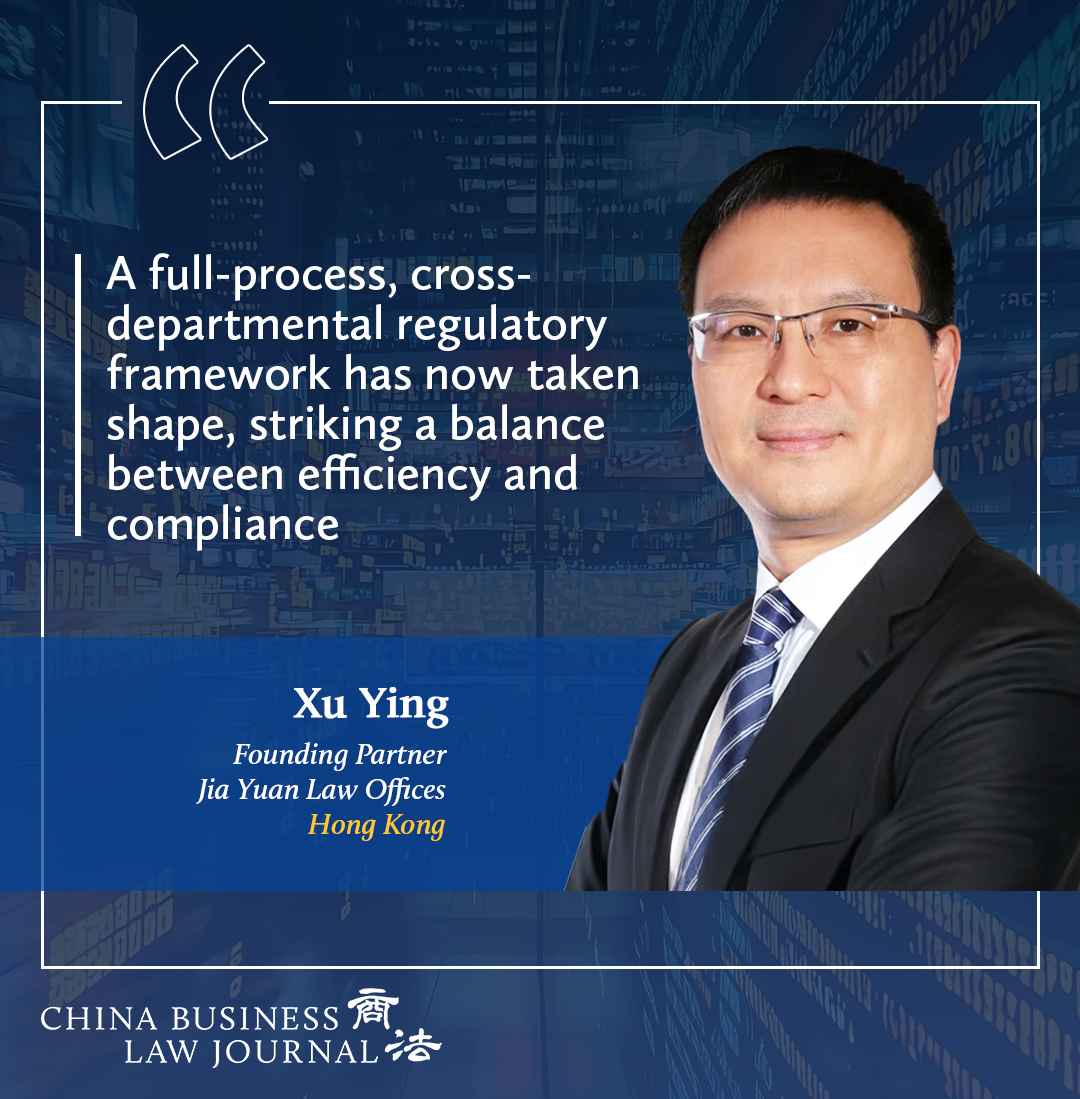

“As mainland enterprises advance global expansion, Hong Kong is solidifying its role as a key platform for industry leaders to raise capital and ramp up overseas presence,” says Xu. “This trend is poised to drive and sustain market vitality for years to come.”
Following the implementation of the enhanced timeframe for the new listing applications, Chow notes that the vetting process has generally accelerated. However, against the backdrop of global economic uncertainties and geopolitical tensions, Tang advises companies to carefully assess their readiness and compliance with Hong Kong’s listing requirements, given the evolving nature of such requirements.
He recommends early engagement and consultation with sponsors, legal advisers and reporting accountants so that material issues and risks can be identified and addressed at an early stage. This helps ensure a more efficient execution of the timetable later on, especially when the launch window may not always be available.
“Further, in order to drive long-term stability, we are hoping to see a more consistent pipeline of mid-sized IPOs coming to the market,” he says.
Guo says that the market-based pricing mechanism of the Hong Kong stock market relies more on institutional investors. Companies planning to go public should focus on engaging professional institutions, such as independent investors with assets under management exceeding HKD1 billion, to boost market confidence.
In addition, they should employ the greenshoe mechanism to reserve over-allotment options to stabilise stock prices, and consider the valuation differences between the Hong Kong and A-share markets when setting prices.
By securing cornerstone investors to lock in subscription commitments, issuers can avoid the risk of issuance failure due to under-subscription. Given the dual regulatory and compliance costs associated with the A+H listings, she also reminds companies to comply with the divergent disclosure requirements and accounting standards in both markets.
US listing breakthrough
While the Hong Kong IPO market is seeing renewed momentum, the path to a US listing remains fraught with uncertainties amid volatile trade policy, recession concerns and geopolitical tensions.
In the first quarter of this year, more than 20 Chinese companies successfully made their US debuts, with the vast majority opting for the Nasdaq. In terms of industry distribution, these newly listed firms have made breakthroughs across diverse sectors including biopharmaceuticals, information technology manufacturing, industrial manufacturing and engineering construction.
“While macro-level challenges persist, such as heightened tariffs under the Trump administration and supply chain scrutiny, differentiated opportunities remain in niche segments,” says Guo.
She points out that the US Securities and Exchange Commission (SEC) currently focuses its scrutiny of US-listed Chinese companies on two prominent issues. The first is data security. Internet companies handling user information must comply simultaneously with China’s Measures for the Security Assessment of Outbound Data Transfer and US privacy regulations.
The second is audit compliance. Under the Holding Foreign Companies Accountable Act, foreign companies listed in the US are required to undergo comprehensive audit inspections by the Public Company Accounting Oversight Board, or else they will face delisting.
At its core, short-term market fervour should not be the primary driving force behind a US listing. Guo advises that companies adopt a long-term capital strategy as the guiding principle, clearly identifying the core value and motivation behind pursuing a US IPO, such as leveraging a global brand premium.
On financial compliance, she recommends that companies continuously improve their earnings quality and capital return levels to enhance their valuation base and competitive edge in the investment market. This will help ensure that the funds raised through new listings meet the initial listing liquidity requirements under the Nasdaq’s new liquidity benchmarks introduced in March this year.
“Regarding regulatory co-ordination, companies must advance both with the CSRC’s filing-based mechanism for overseas listings and the registration procedure with the SEC in parallel,” says Guo. “Special attention should be paid to China’s data security reviews, the compliance arguments of variable interest entities (VIEs) involved in the filing for overseas listings of domestic companies, and the ESG (environmental, social and governance) disclosure requirements of Nasdaq.”
Given the ever-changing market landscape, Guo says that while companies are proactively preparing for their listings they should also pre-arrange an equity restructuring channel to facilitate potential homecoming listings. “By engaging in systematic preparation and dynamic monitoring, companies can ensure readiness to act swiftly once the market window opens,” she says.
Path redefined
In the past two years, the implementation of the filing-based system for overseas listings of domestic companies has fundamentally reshaped both the review timeline and the underlying regulatory logic for Hong Kong and US-bound listings. “A full-process, cross-departmental regulatory framework has now taken shape, striking a balance between efficiency and compliance,” says Xu.
In terms of outcomes, Xu notes that the number of registered companies has continued to rise, with completed filings climbing from 71 in 2023 to 125 in 2024. In the first quarter of 2025 alone, 35 companies have completed their filings.
Regionally, companies from the Yangtze River Delta and the Guangdong-Hong Kong-Macau Greater Bay Area account for more than 60% of the total. The filing timeline has also been significantly streamlined. For standard cases, the average processing duration is about 194 days.
Among these, cases that receive filing notifications through direct listings take an average of just 154 days, while more complex situations such as those involving variable interest entity (VIE) structures still require about 400 days, reflecting the regulators’ cautious and prudent approach.
From a procedural perspective, companies need to navigate a four-stage regulatory process:
-
- the submission of filing materials;
- cross-departmental collaborative review;
- the submission of supplementary materials; and
- the completion of the filing. Standard cases typically clear within two to four months, while complex projects may require more than half a year.
Xu highlights three critical strategies for companies to increase their chances of gaining approval:
-
- Sector prioritisation. Focus on policy-endorsed sectors such as hard tech and consumption upgrades, while avoiding sensitive industries;
- Proactive compliance. Address regulatory red flags early; and
- Regulatory engagement. Initiate pre-filing consultations with regulators to align on disclosure standards and timeline expectations.
A-share paradigm shift
In stark contrast to the booming overseas listing activity, the A-share IPO market remains sluggish. In 2024, the number of A-share IPOs dropped to 100, with total fundraising plunging to RMB67.4 billion. This represents a year-on-year decline of 68% and 81%, respectively, marking the lowest levels in nearly a decade.
More than 400 companies had their IPO applications terminated throughout the year, reflecting the regulators’ increasingly stringent scrutiny of financial authenticity and sustainable business operations.
Despite widespread speculation about the implementation of an “invitation-only” mechanism for A-share IPOs, Guo says that regulators have explicitly denied such claims. Market sentiment has shown some signs of recovery in 2025, but Xu observes that the number of companies successfully filing for A-share IPOs remains limited.
From a sectoral perspective, the Beijing Stock Exchange (BSE) has surpassed the Shanghai Stock Exchange Sci-Tech Innovation Board (Star Market) to become the country’s second-largest IPO board last year, thanks to its “fast-track” review process and its inclusiveness towards small and medium-sized enterprises. Guo expects the BSE IPO market to remain relatively active this year.
Compliance and performance are the twin pillars of a successful listing. Under the enhanced delisting regime, 17 companies were forced to delist in 2024, prompting prospective issuers to strengthen the sustainability of their performance and prevent the risk of post-IPO performance slumps.
“In 2025, the A-share IPO market will continue to shift from ‘scale-driven expansion’ to ‘quality-first growth’,” says Guo. “Companies must abandon the mindset of ‘breaking through the checkpoints’, focusing instead on financial rigor and operational compliance, and building competitive moats through technological innovation, market expansion and risk management to achieve sustainable development in a market environment characterised by ‘tightened oversight, enhanced compliance, and performance-driven governance’.”
In a similar vein, the cooling trend has equally impacted the SPAC and de-SPAC (a transaction that enables a company to go public by merging with a SPAC) sectors. While some de-SPAC deals have successfully closed recently, overall activity has remarkably declined compared to the previous boom, according to Stephen Luo, a partner at Jingtian & Gongcheng in Hong Kong.
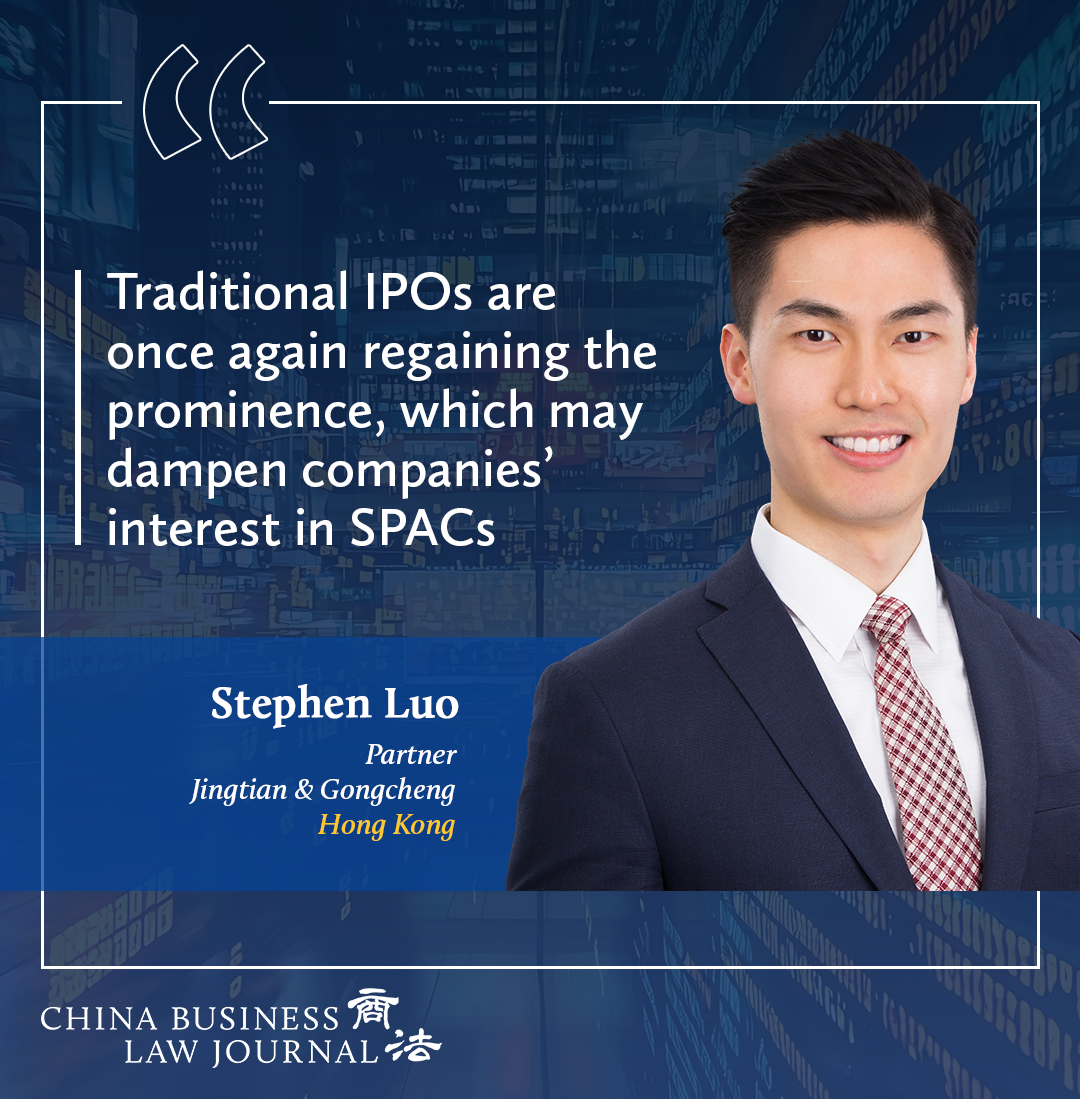

Luo explains that the primary advantage of SPAC listings lies in improving the likelihood of a successful offering, particularly during periods of heightened market uncertainty. “However, with the gradual recovery of global capital markets in recent months, traditional IPOs are once again regaining the prominence, which may dampen companies’ interest in SPACs.”
From a developmental perspective, Guo observes a clear divergence in SPAC and de-SPAC activity across major global capital markets. In more mature SPAC markets such as the US, many investors have grown wary of the risks associated with this model, including potential fraud and lower stock returns, which leads to diminished enthusiasm.
In contrast, Asian markets maintain a degree of interest in acquisition vehicles, with Hong Kong and Singapore actively introducing or refining relevant frameworks to attract more innovative companies. “Both jurisdictions impose stricter regulations on SPACs compared to the US, which inevitably results in higher investment thresholds, subdued market activity and prolonged listing timelines,” says Guo.
Looking ahead, Luo stresses that as an innovative form of capital operation, SPACs still hold value and appeal for companies seeking strategic financial support and a faster track to listing, thanks to the high-quality investor resources behind them. However, their applicability and attractiveness will largely depend on the broader market environment and the specific needs of individual companies.
New gatekeepers of Hong Kong listings
In the past two decades, each wave of mainland Chinese enterprises eyeing listings in Hong Kong has mirrored profound shifts in the endogenous drivers of China’s economic development.
From the restructuring and listings of large state-owned H-share companies in the 2000s, to the listing spree of real estate and retail consumer companies fueled by domestic demand in the 2010s; from the 2018 introduction of new listing rules by the Hong Kong Exchanges and Clearing for pre-revenue and pre-profit technology and biotech firms, and the homecoming of US-listed Chinese enterprises, which attracted swathes of biotech and internet technology companies to make their Hong Kong debuts, to the more recent launch of a new listing regime for specialist technology companies alongside the “A+H” dual listing leading the charge in hard tech and new quality productive forces, this marks a new chapter for Hong Kong’s capital market.
Each of these milestones, in the view of Nan Li, the managing director of Tian Yuan Law Firm’s Hong Kong office, vividly reflects the evolution of China’s pillar industries and the dynamic process of industrial upgrading.
In 2019, Nan Li’s team joined the firm, having previously been part of an international law firm. According to Li, the team has proven to the market that Chinese law firms’ Hong Kong branches now deliver comparable quality and capabilities to their international counterparts.
Free from the operational disruptions caused by foreign headquarters’ geopolitically driven restructuring or staff redundancy mandates, the team maintains greater stability in both talent retention and morale.
“As a Chinese law firm, our interests organically align with those of Chinese enterprises,” says Li. “We are not subject to foreign governments’ political correctness or sanctions policies, and we will not encounter situations where clients being placed on a sanctions list leaves us no option but to resign.”
Stephen Luo, a partner at Jingtian & Gongcheng in Hong Kong, opines that providing both Hong Kong and foreign legal advice on IPO projects in Hong Kong has become an inevitable choice and strategic imperative for the Hong Kong branches of Chinese law firms.
This essentially aligns with industry trends and meets the surging demand from mainland companies seeking Hong Kong listings. Their core advantage lies in robust cross-border co-ordination capabilities.
By leveraging the resources and platform of their mainland headquarters, these firms can deliver comprehensive legal services spanning both the mainland China and Hong Kong legal systems. Such a seamless service model is something that Hong Kong and international law firms often find challenging to fully replicate.
“As Chinese law firms’ Hong Kong branches continue to enhance their operational capabilities and accumulate experience, the traditional strengths of international law firms are gradually being eroded,” says Luo. “The former’s more competitive fee structures and closer ties with mainland clientele are putting mounting market pressures on the latter.”
Luo adds that the inherent limitations of Hong Kong law firms in meeting the needs of mainland clients and delivering integrated cross-border services have made it more difficult for them to attract clients. “This dynamic is driving a gradual evolution of the legal services landscape in Hong Kong’s capital markets, increasingly favouring players with comprehensive cross-jurisdictional service competencies.”
For Li, Hong Kong’s strategic goal is becoming more pronounced. “Hong Kong is a global financial centre, and it is also China’s global financial hub. The superpower rivalry will be a defining theme throughout the first half of the 21st century, making Hong Kong’s capital markets increasingly critical for Chinese enterprises in their overseas expansion and financing efforts,” says Li.
“The core interests of Chinese companies need to be safeguarded by professional institutions and professionals whose interests are fully aligned with theirs. This is also the very foundation that gives Chinese-funded service organisations such as funds, investment banks and law firms the confidence to thrive in Hong Kong.”



















